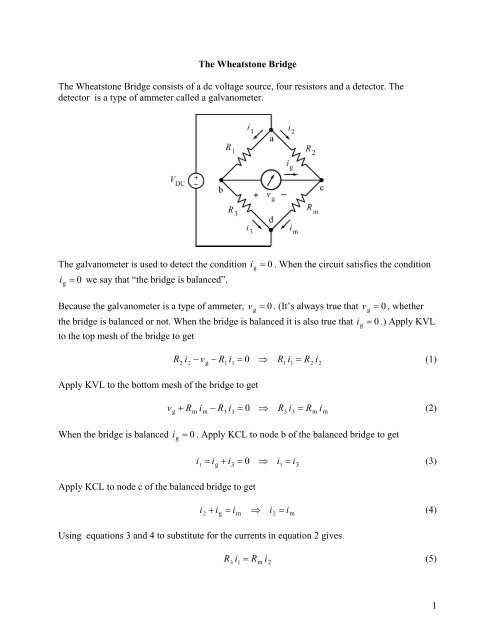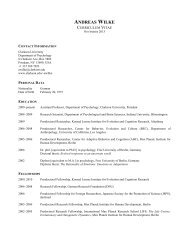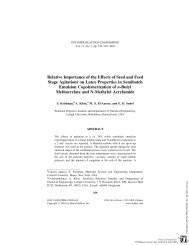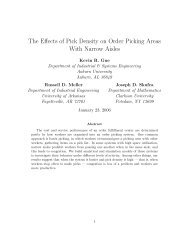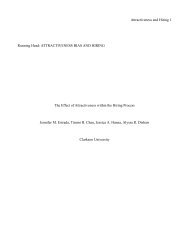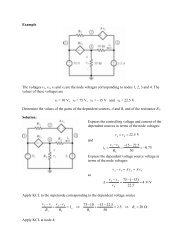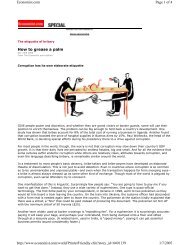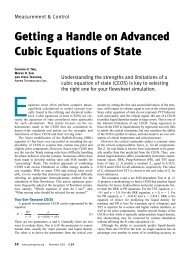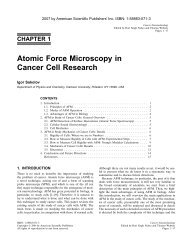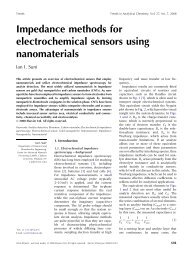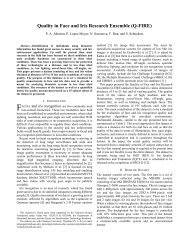Wheatstone Bridge
Wheatstone Bridge
Wheatstone Bridge
You also want an ePaper? Increase the reach of your titles
YUMPU automatically turns print PDFs into web optimized ePapers that Google loves.
The <strong>Wheatstone</strong> <strong>Bridge</strong><br />
The <strong>Wheatstone</strong> <strong>Bridge</strong> consists of a dc voltage source, four resistors and a detector. The<br />
detector is a type of ammeter called a galvanometer.<br />
The galvanometer is used to detect the condition i g = 0 . When the circuit satisfies the condition<br />
i = 0<br />
g<br />
we say that “the bridge is balanced”.<br />
Because the galvanometer is a type of ammeter, v g = 0 . (It’s always true that v g = 0 , whether<br />
the bridge is balanced or not. When the bridge is balanced it is also true that i = 0 .) Apply KVL<br />
to the top mesh of the bridge to get<br />
R i −v− Ri = 0 ⇒ Ri = Ri<br />
(1)<br />
2 2 g 1 1 1 1 2 2<br />
Apply KVL to the bottom mesh of the bridge to get<br />
vg + Rmim − R3i3 = 0 ⇒ R3i3 = Rmim When the bridge is balanced i = 0 . Apply KCL to node b of the balanced bridge to get<br />
g<br />
i = i + i = ⇒ i = i<br />
(3)<br />
1 g 3 0<br />
Apply KCL to node c of the balanced bridge to get<br />
1 3<br />
i + i = i ⇒ i = i<br />
(4)<br />
2 g m 2 m<br />
Using equations 3 and 4 to substitute for the currents in equation 2 gives<br />
g<br />
(2)<br />
R3i1= Rmi2 (5)<br />
1
Dividing equation 5 by equation 1 gives<br />
Now and solving for R m we get<br />
R3 m R<br />
= (6)<br />
R R<br />
1 2<br />
R2<br />
Rm = R3<br />
(6)<br />
R<br />
Typically, 1 R and 2 R are fixed resistors and 3 R is a variable resistor. R m is the resistance that<br />
is being measured. R 3 is adjusted until the detector indicates that the bridge is balanced. Then<br />
the value of R m is determined using equation 6.<br />
Example<br />
Consider using a <strong>Wheatstone</strong> bridge having R 1 = 200 Ω and R 2 = 2000 Ω to measure a<br />
resistance R m . The bridge is balanced by adjusting 3 R until R 3 = 250 Ω . What is the value of<br />
R m ?<br />
Solution<br />
From equation 6<br />
R2<br />
2000<br />
Rm= R3=<br />
250 = 2500 Ω<br />
R 200<br />
1<br />
Example<br />
Consider using a <strong>Wheatstone</strong> bridge having R 1 = 200 Ω and R 2 = 2000 Ω to measure a<br />
resistance, R m , of a temperature sensor. Suppose the resistance of the temperature sensor, R m ,<br />
in Ω, is related to the temperature T, in °C, by the equation<br />
R = 1500 + 25T<br />
m<br />
The bridge is balanced by adjusting 3 R until R 3 = 250 Ω . What is the value of the temperature?<br />
Solution<br />
From equation 6<br />
Next, the temperature in °C is given by<br />
R2<br />
2000<br />
Rm= R3=<br />
250 = 2500 Ω<br />
R 200<br />
1<br />
m 1500 R − 2500 −1500<br />
1000<br />
T = = = = 40 ° C<br />
25 25 25<br />
1<br />
2
Example<br />
Consider using a <strong>Wheatstone</strong> bridge having R 1 = 200 Ω and R 2 = 2000 Ω to measure a<br />
resistance, R m , of a temperature sensor. Suppose the resistance of the temperature sensor, R m ,<br />
in Ω, is related to the temperature T, in °C, by the equation<br />
R = 1500 + 25T<br />
m<br />
The temperature is expected to vary over the range 0 to 100 °C. Over what range must R 3 vary<br />
in order for the bridge to measure temperature over the range 0 to 100 °C?<br />
Solution:<br />
Solve equation 6 for R 3 :<br />
When T = 0 °C, Ω and 1500 R =<br />
m<br />
When T = 100 °C, ( )<br />
m<br />
2<br />
R1<br />
R3 = Rm<br />
(7)<br />
R<br />
R1<br />
200<br />
R3= Rm=<br />
1500 = 150 Ω<br />
R 2000<br />
R = 1500 + 25 100 = 4000 Ω and<br />
R1<br />
200<br />
R3= Rm=<br />
4000 = 400 Ω<br />
R 2000<br />
2<br />
R 3 could be implemented as a 150 Ω resistor in series with a 250 Ω potentiometer:<br />
2<br />
3


